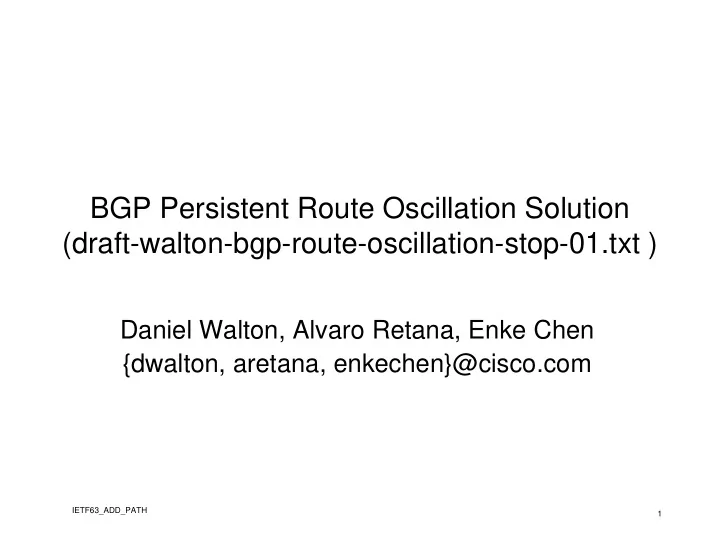

BGP Persistent Route Oscillation Solution (draft-walton-bgp-route-oscillation-stop-01.txt ) Daniel Walton, Alvaro Retana, Enke Chen {dwalton, aretana, enkechen}@cisco.com IETF63_ADD_PATH 1
What is the problem? • BGP Persistent Route Oscillation Condition (rfc3345) – Combination of RR and/or confederations with the use of MED, may cause persistent route oscillations. • Type I = single-level Route Reflection or AS Confederations – Solved by following the Deployment Considerations in rfc2796 and/or rfc3065. • Type II = More than one tier of Route Reflection or Sub-ASs – Not all workarounds are operationally feasible. IETF63_ADD_PATH 2
Is the problem real? • Yes!! – Several ISPs have been experiencing the oscillation (on dual-tier deployments). • Real world numbers (taken a couple of years ago – average of several measurements): – Total number of routes: 112086 – Oscillation Candidates: 9011 – Oscillating Routes: 899 IETF63_ADD_PATH 3
Solution (1) • In a network with a full iBGP mesh, all routers have consistent and equivalent routing information – the MED-type oscillation doesn’t occur. • Solution: allow the advertisement of all available paths in order to recreate the consistent and equivalent view. – Results in the same amount of routing information as a full iBGP mesh. IETF63_ADD_PATH 4
Solution (2) • A BGP speaker (route reflector or a sub-AS border router) MUST advertise the following to its iBGP or confederation peers: – The "neighbor AS based Group Best Path“, for each neighbor AS (which includes the best path) • Notes: – "neighbor AS based Group Best Path" = path considered best among all paths from the same neighbor AS – Only "neighbor AS based Group Best Paths" for which the tie breaker (when comparing the path to the best path) occurs after the MED is compared need to be propagated. – Result = each speaker will advertise at most n "neighbor AS based Group Best Paths" to its non-eBGP peers (one for each neighbor AS), including the best path. IETF63_ADD_PATH 5
Next Steps • Adopt this draft as a WG document – Addresses a hole in the way BGP is specified today. – Solves a real problem in deployed networks. – Relatively low impact if additional routes are propagated when the MED oscillation is detected. IETF63_ADD_PATH 6
Advertisement of Multiple Paths in BGP (draft-walton-bgp-add-paths-03) Daniel Walton, Alvaro Retana, Enke Chen {dwalton, aretana, enkechen}@cisco.com IETF63_ADD_PATH 7
Proposal • Mechanism that allows the advertisement of multiple paths for the same prefix without the new paths implicitly replacing any previous ones. – Summary: add a path identifier to the encoding. – The intent of this extension is to be used in a controlled fashion for applications that require only partial propagation of the routing information, or specific individual recipients. IETF63_ADD_PATH 8
NLRI Encoding • Extension to Multiprotocol Extensions for BGP-4 (RFC 2858) and the base spec (RFC 1771). – The Path Identifier field is used to distinguish between different prefixes. +-----------------------------+ +-----------------------------+ | Path Identifier (4 octets) | | Path Identifier (4 octets) | +-----------------------------+ +-----------------------------+ | Length (1 octet) | | Length (1 octet) | +-----------------------------+ +-----------------------------+ | Prefix (variable) | | Prefix (variable) | +-----------------------------+ +-----------------------------+ IETF63_ADD_PATH 9
NLRI Encoding (Cont.) • Extension to Carrying Label Information in BGP-4 (RFC 3107). +-----------------------------+ +-----------------------------+ | Path Identifier (4 octets) | | Path Identifier (4 octets) | +-----------------------------+ +-----------------------------+ | Length (1 octet) | | Length (1 octet) | +-----------------------------+ +-----------------------------+ | Label (3 octets) | | Label (3 octets) | +-----------------------------+ +-----------------------------+ ............................... ............................... +-----------------------------+ +-----------------------------+ | Prefix (variable) | | Prefix (variable) | +-----------------------------+ +-----------------------------+ IETF63_ADD_PATH 10
Capability Advertisement • New Capability: ADD-PATH – Code TBD – Length is variable.. • Value: 0 or more tuples: +------------------------------------------------+ | Address Family Identifier (2 octets) | +------------------------------------------------+ | Subsequent Address Family Identifier (1 octet) | +------------------------------------------------+ | Path Identifier Type (1 octet) | +------------------------------------------------+ Used for display/troubleshooting. IETF63_ADD_PATH 11
Capability Advertisement • Update in -04 Version to be published after IETF • New Capability: ADD-PATH – Code TBD – Length is variable.. • Value: 0 or more tuples: +------------------------------------------------+ | Address Family Identifier (2 octets) | +------------------------------------------------+ | Subsequent Address Family Identifier (1 octet) | +------------------------------------------------+ IETF63_ADD_PATH 12
Operation • Advertisement of the capability indicates ability to receive multiple paths for all negotiated AFI/SAFIs. • Advertisement of specific AFI/SAFI information in the capability indicates the intent to send multiple paths for it. – Only in this case must the new encoding be used. IETF63_ADD_PATH 13
Applications • MED Oscillation • Several multipath applications • Route Server • Other applications are left for further study. IETF63_ADD_PATH 14
Next Step • Adopt this draft as a WG document • Update rfc3107 to use the proposed encoding for the advertisement of multiple paths and remove the capability code it defined. IETF63_ADD_PATH 15
Recommend
More recommend